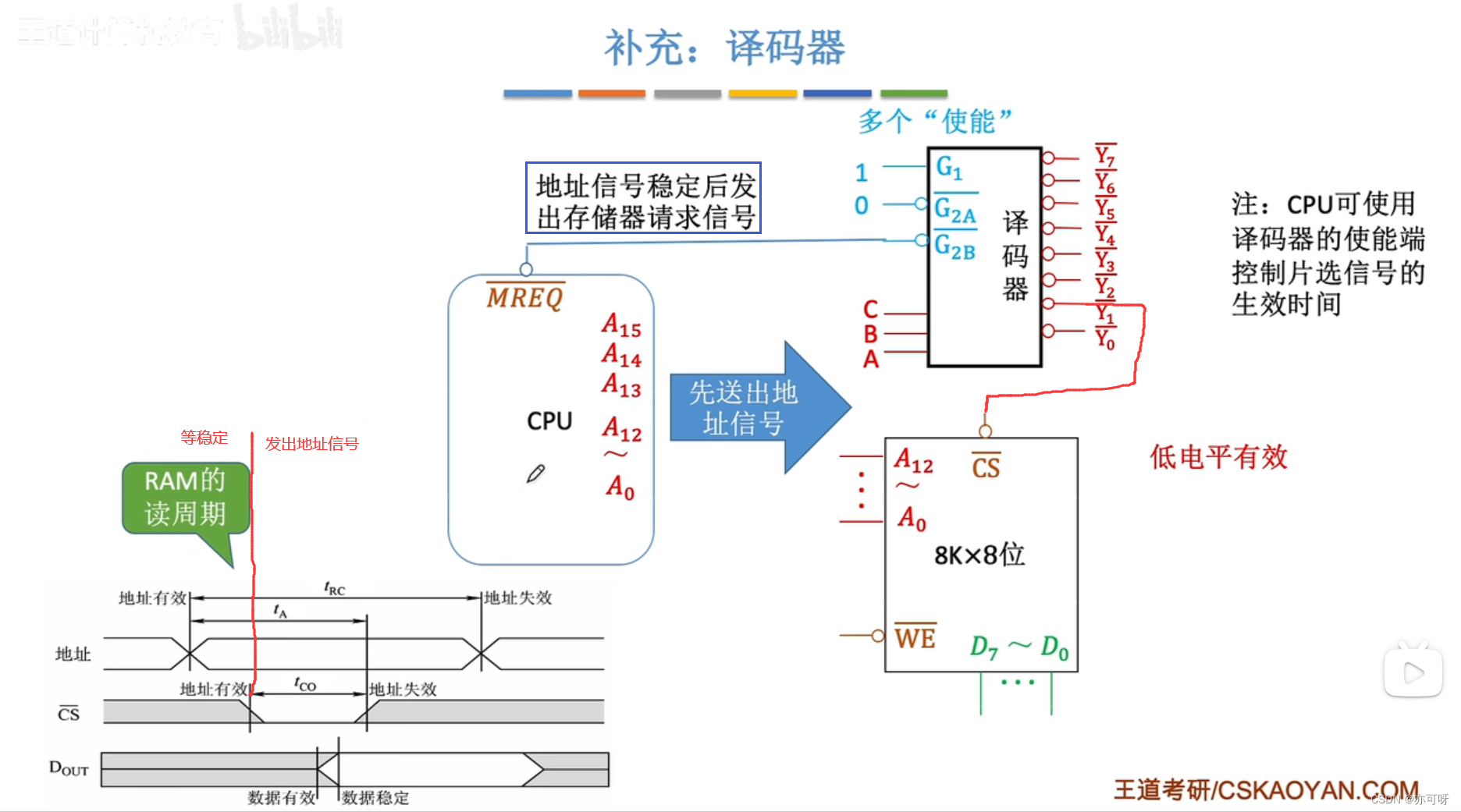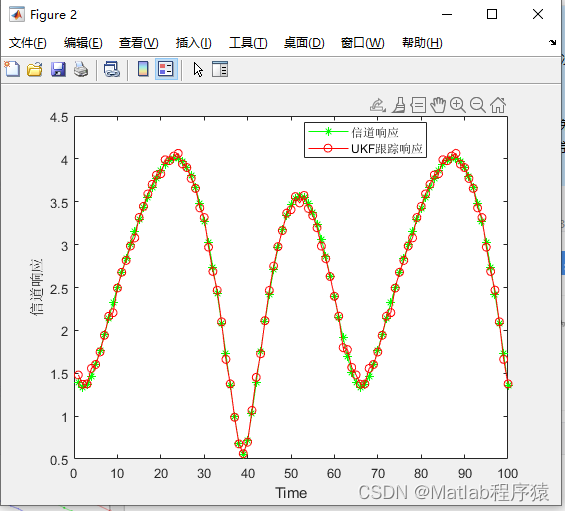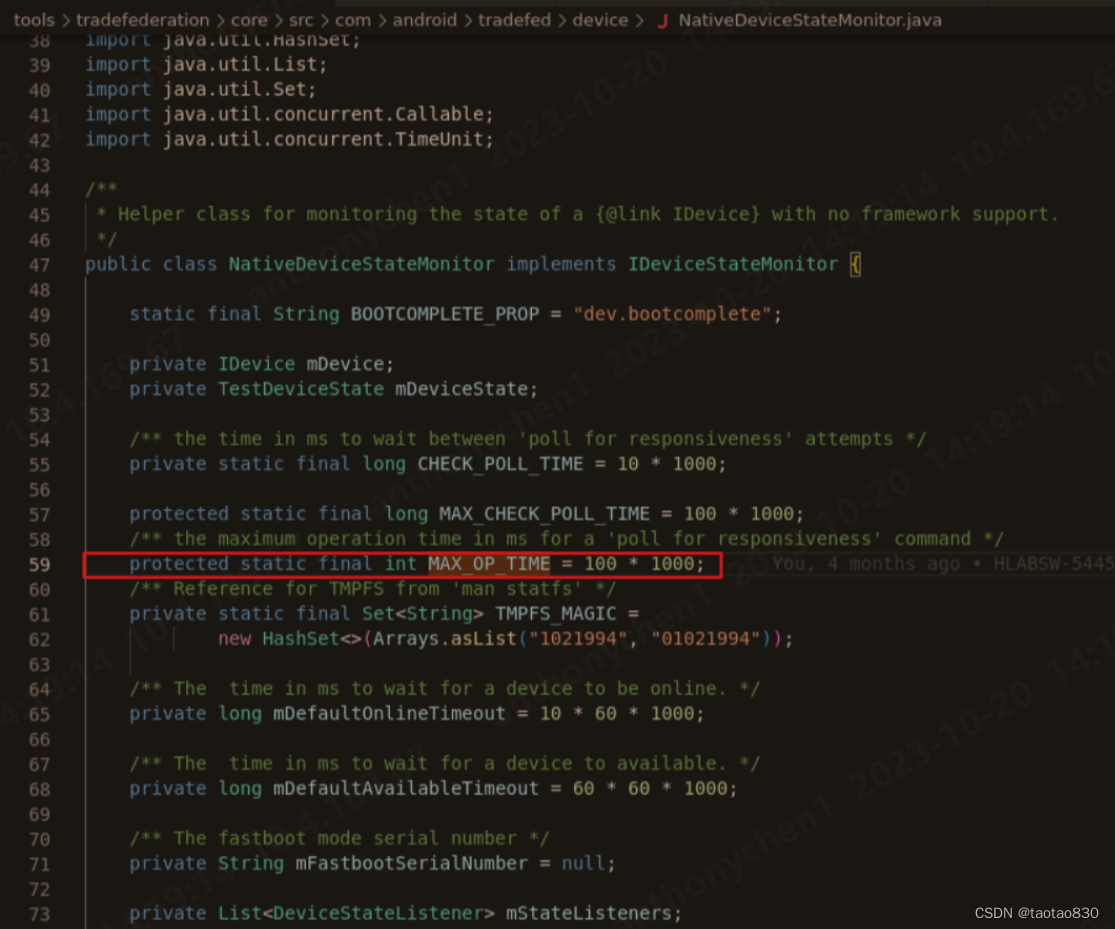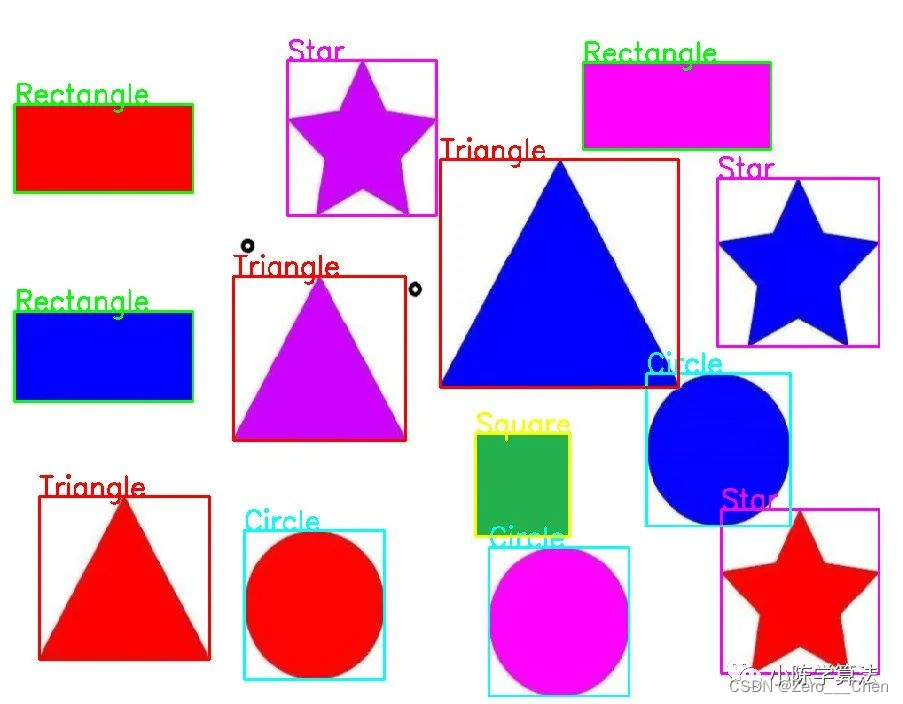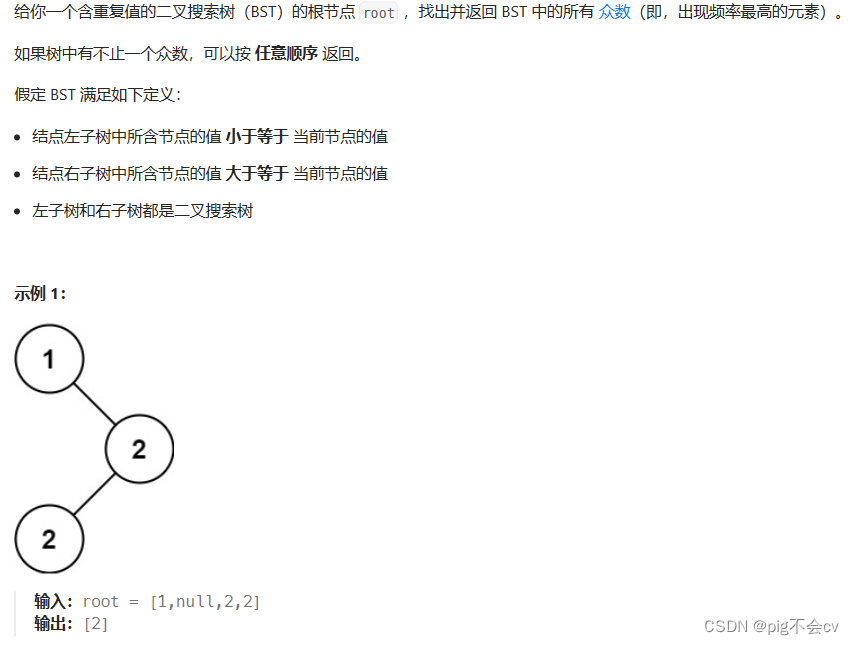 算法:
算法:
提到二叉搜索树,一定是中序遍历!
双指针法:
pre指向当前节点cur的前一个节点,如果cur.val= pre.val,count++,count用来统计该数值出现的频率
如果 频率count 等于 maxCount(最大频率),当然要把这个元素加入到结果集中。
万一,这个maxCount此时还不是真正最大频率呢。
频率count 大于 maxCount的时候,不仅要更新maxCount,而且要清空结果集(以下代码为result数组),因为结果集之前的元素都失效了。
调试过程:
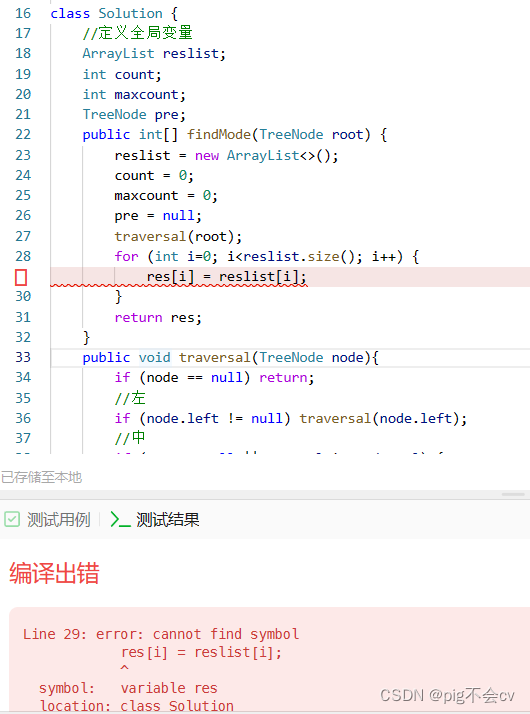
原因:
在Java中,`resList[i]` 是不合法的语法,因为`ArrayList`并不支持通过索引直接访问元素。相反,它使用 `get` 方法来获取特定索引处的元素,因此正确的语法是 `resList.get(i)`。
数组(Array)支持通过索引直接访问元素,因此可以使用 `res[i]` 来访问数组中的元素。但是对于列表(ArrayList)来说,需要使用 `get` 方法来访问特定索引处的元素。
因此,正确的写法是 `res[i] = resList.get(i);
而且,res没有初始化、定义
修改后:
/**
* Definition for a binary tree node.
* public class TreeNode {
* int val;
* TreeNode left;
* TreeNode right;
* TreeNode() {}
* TreeNode(int val) { this.val = val; }
* TreeNode(int val, TreeNode left, TreeNode right) {
* this.val = val;
* this.left = left;
* this.right = right;
* }
* }
*/
class Solution {
//定义全局变量
ArrayList reslist;
int count;
int maxcount;
TreeNode pre;
public int[] findMode(TreeNode root) {
reslist = new ArrayList<>();
count = 0;
maxcount = 0;
pre = null;
int[] res = new int[reslist.size()];
traversal(root);
for (int i=0; i<reslist.size(); i++) {
res[i] = reslist.get(i);
}
return res;
}
public void traversal(TreeNode node){
if (node == null) return;
//左
if (node.left != null) traversal(node.left);
//中
if (pre == null || pre.val != node.val) {
count = 1;
}
else {
count++;
}
if (count > maxcount) {
reslist.clear();
maxcount = count;
reslist.add(node.val);
}
else if (count == maxcount) {
reslist.add(node.val);
}
pre = node;
//右
if (node.right != null) traversal(node.right);
}
}
原因:
问题出在 `ArrayList reslist` 的定义上。在 Java 中,如果你没有指定泛型类型,`ArrayList` 默认会将其元素视为 `Object` 类型。因此,在 `int[] res = new int[reslist.size()];` 这一行中,你创建了一个大小为 0 的 int 数组,因为此时 `reslist` 中还没有添加任何元素。
为了解决这个问题,你应该明确定义 `ArrayList` 的元素类型为 `Integer`,而不是使用默认的 `Object`。
修改后:
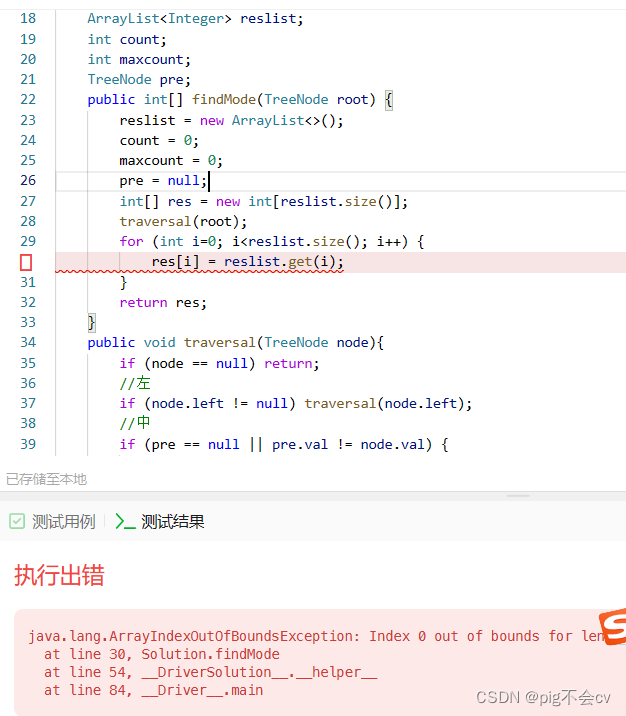
原因:
问题出在创建结果数组 `res` 的时候。在 `int[] res = new int[reslist.size()];` 这一行代码之后立即调用了 `traversal(root);`,这会导致 `res` 数组的大小仍然为0,因为此时 `reslist` 中还没有添加任何元素。
为了解决这个问题,应该将 `int[] res = new int[reslist.size()];` 放在 `traversal(root);` 之后。这样,当 `traversal` 方法执行完毕后,`reslist` 中会包含所有的结果,然后你才能创建相应大小的 `res` 数组,并将结果放入其中。
正确代码:
/**
* Definition for a binary tree node.
* public class TreeNode {
* int val;
* TreeNode left;
* TreeNode right;
* TreeNode() {}
* TreeNode(int val) { this.val = val; }
* TreeNode(int val, TreeNode left, TreeNode right) {
* this.val = val;
* this.left = left;
* this.right = right;
* }
* }
*/
class Solution {
//定义全局变量
ArrayList<Integer> reslist;
int count;
int maxcount;
TreeNode pre;
public int[] findMode(TreeNode root) {
reslist = new ArrayList<>();
count = 0;
maxcount = 0;
pre = null;
traversal(root);
int[] res = new int[reslist.size()];
for (int i=0; i<reslist.size(); i++) {
res[i] = reslist.get(i);
}
return res;
}
public void traversal(TreeNode node){
if (node == null) return;
//左
if (node.left != null) traversal(node.left);
//中
if (pre == null || pre.val != node.val) {
count = 1;
}
else {
count++;
}
if (count > maxcount) {
reslist.clear();
maxcount = count;
reslist.add(node.val);
}
else if (count == maxcount) {
reslist.add(node.val);
}
pre = node;
//右
if (node.right != null) traversal(node.right);
}
}注意:
结果集是ArrayList,要转变成数组。(题目里面的输出结果是数组)
原始的 `reslist` 是一个 ArrayList,它可以动态增长,但在返回结果时,通常更方便将其转换为固定大小的数组。这样做可以更好地符合函数的返回类型,并且更方便在其他地方使用结果。
时间空间复杂度
时间复杂度分析
- 在遍历二叉树的过程中,对于每个节点,我们执行了常数次操作(比较、更新计数器、添加到结果列表等)。
- 假设树中有 (n) 个节点,则时间复杂度为 (O(n)),因为我们对每个节点只进行了常数次操作。
空间复杂度分析
- 空间复杂度取决于递归调用的深度,即树的高度。在最坏的情况下,如果树是一个链状结构,递归调用的深度将是 (O(n))。
- 此外,我们使用了一个 ArrayList 来存储结果,其空间占用与树中节点个数相关,因此空间复杂度也是 (O(n))。
算法的时间复杂度为 (O(n)),空间复杂度也是 (O(n))。






